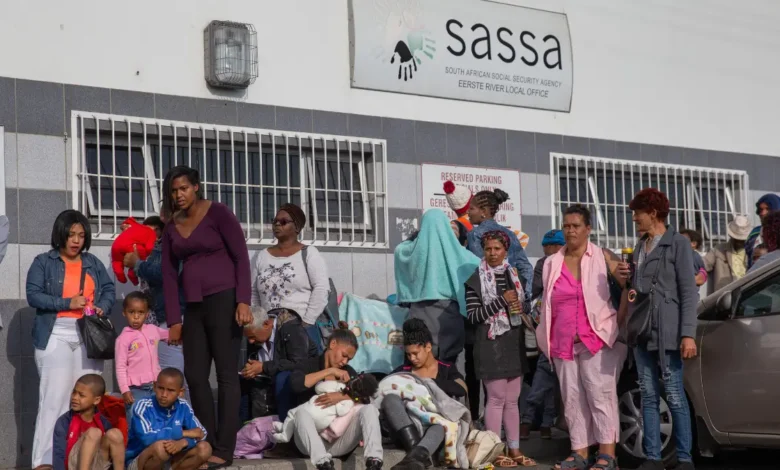Social Grants Growth Plan: 5.4M Older Persons & 14.1M Children Covered by 2030

The Department of Social Development has unveiled an ambitious roadmap to widen South Africa’s social safety net, targeting millions of additional beneficiaries by 2030. Aligned with the National Development Plan (NDP) Vision 2030, the Medium-Term Development Plan (MTDP) and the Department’s Strategic Plan (2025–2030) set clear targets despite tight budgets. Here’s how the Department plans to bolster social grants and related support over the next five years.
ALSO READ: Mandatory SASSA Biometric Enrolment: Who Needs to Register?
1. Dramatic Growth in Social Grant Coverage
By 2030, the Department aims to support:
- Older Persons’ Grants: Expand from today’s level to 5.4 million beneficiaries, up from a mid-term target of 5 million by 2027–28.
- Child Support Grants: Increase coverage to 14.1 million children.
- Disability Grants: Grow the roll to over 1.1 million recipients.
Deputy Minister Ganief Hendricks highlighted Vision 2030’s mandate “to eradicate food poverty by 2030,” proposing that non-working beneficiaries receive at least R760, with an eventual goal of R1 000 per month to lift the most vulnerable out of extreme hardship.
2. Strategic and Annual Performance Plans
The Department’s Strategic Plan 2025–2030 outlines its long-term priorities, while the Annual Performance Plan 2025–2026 zeroes in on immediate deliverables. Together with the Medium-Term Expenditure Framework (MTEF)—a three-year budget forecasting tool—and the National Development Plan, these documents ensure that social-welfare targets remain on track despite fiscal constraints.
- MTDP Priorities
- Inclusive growth & job creation
- Poverty reduction & cost-of-living relief
- A capable, ethical, developmental state
- Budget Realities
The 2025/26 baseline budget allocates R294 billion to the Social Relief of Distress (SRD) grant, with funding tapering in subsequent years. To accommodate a 5.5% public-servant pay increase, the Department had to reallocate from goods and services, underscoring its “do more with less” mandate.
3. Groundbreaking Social Development Legislation
For the first time in 30 years of democracy, South Africa will have a dedicated Social Development Act. Deputy Minister Hendricks told Parliament’s portfolio committee that Cabinet will receive the bill by October 2025. This historic legislation promises to:
- Define grant-delivery mandates
- Streamline interdepartmental collaboration
- Embed accountability and service standards
Sector stakeholders are also pushing for specialized legislation—such as a Disability Rights Act and a Substance-Abuse Control Act—to address unique social challenges more effectively.
4. Nine Portfolio Commitments
As the 2030 horizon approaches, the Department distilled its priorities into nine portfolio commitments:
- Food Security
- Reach 1.5 million people via nutrition programs by 2027–28.
- Optimized Social Protection
- Maximize grant value within fiscal limits.
- Substance-Abuse Treatment
- Assist 135 000 users by mid-term and 273 000 by 2030.
- Gender-Based Violence (GBV) Support
- Offer psychosocial services to 224 549 survivors by mid-term and 449 048 by 2030.
- Integrated Poverty Alleviation
- Link social grants with livelihood initiatives.
- Sustainable Livelihoods
- Move 1.4 million households out of grant dependency by 2027–28; 2.9 million by 2030.
- Community Resilience
- Strengthen family and community support structures.
- Ethical Service Delivery
- Promote transparent governance across all nine provinces.
- Monitoring & Evaluation
- Conduct quarterly oversight visits and report progress to Parliament.
Committee Chairperson Bridget Masango urged a focus on youthful “dignity poverty,” noting that long-term SRD recipients under 35 lack sustainable pathways to self-sufficiency.
5. From Dependency to Empowerment
Minister Hendricks and Director-General Fhumulani Netshipale emphasized transitioning beneficiaries off grants and into sustainable livelihoods. The National Development Agency will spearhead business-incubation programs, micro-enterprise support, and vocational training to reduce the 45% dependency rate on social grants.
6. Strengthened Provincial Oversight
The Department will intensify provincial monitoring to close implementation gaps. Netshipale committed to quarterly performance reviews across all provinces, ensuring services align with baseline targets. This marks a shift from historical reporting to a more rigorous, data-driven accountability model.
7. Balancing Ambition Against Budget Constraints
CFO Fanie Esterhuizen reported no major budget cuts for 2025–28 but warned that grant increases—such as the proposed R120 (reduced from R150), must come from existing allocations. The Department must carefully balance expansion goals with fiscal responsibility, prioritizing cost-effective interventions and partnerships with NGOs and the private sector to stretch each rand.
South Africa’s bold expansion of its social safety net by 2030 seeks to eradicate food poverty, boost grant coverage to over 20 million beneficiaries, and address pressing social ills. By weaving together the NDP Vision, MTDP, MTEF, and annual plans, the Department of Social Development aims to transform lives while navigating tight budgets. Success hinges on robust legislation, focused portfolio commitments, and a determined shift toward sustainable livelihoods—ensuring that by 2030, South Africa not only cares for its most vulnerable but empowers them to thrive.